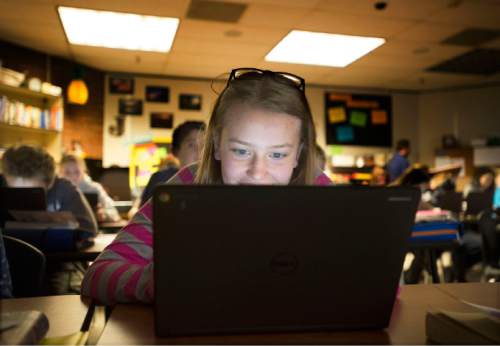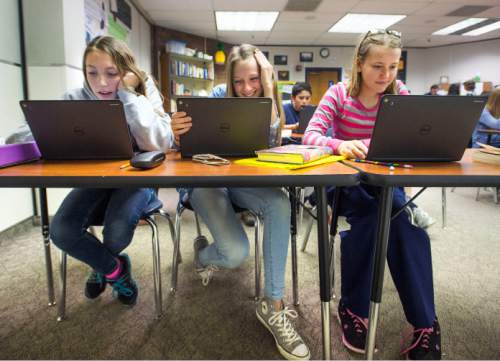This is an archived article that was published on sltrib.com in 2016, and information in the article may be outdated. It is provided only for personal research purposes and may not be reprinted.
When the Utah Legislature convenes next week, lawmakers will face a $100 million request from state education managers to beef up classroom technology.
But most Utahns don't think the state should be in the digital learning business, according to a new statewide poll of registered voters.
Only 34 percent of respondents said the state should pay for every student to have a computer in the classroom, compared with 53 percent who answered no.
The idea was less popular among Republicans, 26 percent of whom said the state should buy a computer for every student, compared with 48 percent of Democrats.
"We're having trouble keeping teachers in classrooms. We're having trouble with class size. There are bigger issues than whether or not we have technology," said Sharon Gallagher-Fishbaugh, president of the Utah Education Association.
Many schools and school districts, she said, have already chosen to invest in mobile devices and learning software. The issue, she said, is when state funds are earmarked for technology, which restricts how revenue can be used and ties the hands of local administrators.
The poll, commissioned by The Salt Lake Tribune and the Hinckley Institute of Politics, was conducted between Jan. 6 and Jan. 13 by SurveyUSA. It includes responses from 989 registered voters and has a margin of error of plus or minus 3.2 percentage points.
In 2014, then-House Speaker Becky Lockhart proposed a bill to purchase a mobile learning device — such as a tablet or laptop computer — for every student in the public education system.
The bill, known as a one-to-one device initiative, would have cost between $200 million and $300 million, but it failed at the Legislature due to its price tag and a veto threat from Gov. Gary Herbert.
One-to-one plans have been implemented in some states to varying degrees of success. The Los Angeles Unified School District planned to distribute about 700,000 tablet computers to students — at a cost of $1.3 billion — but canceled the program in August 2014 amid criticisms that resulted in the resignation of Superintendent John Deasy.
As a result of failures like the Los Angeles program and the Lockhart bill, the conversation among Utah policymakers has shifted from putting computers in the hands of every student to using technology for individualized classroom instruction. "I would answer 'no' to that [poll] question because it's not about the device," said state Sen. Howard Stephenson, R-Draper.
Stephenson sponsored legislation last year to create a task force to develop a plan for digital learning in the state.
That plan, Essential Elements, calls for $100 million — $50 million to get the program started and $50 million for the first year, with $50 million to come each year after that — to fund technology grants for Utah's 41 school districts.
David Thomas, vice chairman of the state school board, said the Essential Elements plan is not a state-mandated one-to-one initiative.
Instead, he said, school districts would make their own technology plans, which could include mobile devices for students, Internet and infrastructure upgrades, and software training for teachers.
He also said the program would not be entirely funded by the state, with districts expected to contribute their own resources to implement plans.
"Poll questions are fine," he said, "but the actual master plan that the task force put forward and the state [school] board approved is a comprehensive plan that transforms the way education is delivered in the classroom."
Thomas said part of the lukewarm reaction to school technology by voters could be attributed to the novelty of digital learning.
Many people can only picture tablets and laptops being used as digital textbooks, he said, which barely scratches the surface of how a 21st century classroom can personalize learning for students.
"Unless you've been in a classroom with a teacher who is capable of using this technology," he said, "you have a hard time wrapping your head around it because it is different than what we grew up with."
But Gallagher-Fishbaugh said the school board's grant program still requires school districts to spend $100 million of education funding on technology, whether they want to or not.
She praised Herbert's proposed budget, which prioritizes unrestricted funds that can be spent at the discretion of local school boards on a per-student basis.
"The local districts know their needs better than the state," she said.
Thomas said there's enough surplus education funds this year to increase per-student spending and launch the technology program.







